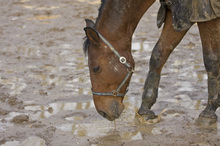Ask any longtime horse owner what they dislike most when it comes to maintaining their stable and barn area and many will say, âmud." Unfortunately winter weather brings ice, snow and rain to many areas and when the weather warms even slightly, many horse owners are dealing with mud in their horseâs paddocks and pastures.

Mud in horse pastures - A safety, and health hazard
Mud is not only a nuisance, but it can also be a safety and a health hazard for horses because it contains bacteria that can cause diseases and can also lead to injuries like bowed tendons.
Mud is not only a nuisance but it can also be a safety and a health hazard for horses. Deep mud can cause injuries like bowed tendons. Deep mucky mud can be tough on horses with arthritis and can pull shoes from your horses feet.
In addition, mud, when mixed with manure can harbor harmful bacteria â creating an ideal environment for thrush, scratches, and rain rot in horse's feet and on their legs.
According to a press release from the University of Arkansas Department of Agriculture, horse owners need to keep a close eye on their charges' hoofs when they are walking around in the mud. "Most horses deal pretty well in the mud, but if they have shoes on, then there is a great chance the shoes will get sucked off," said Mark Russell, instructor-equine, for the U of A Division of Agriculture. "It's better if you can keep their feet bare if they will spend any long period of time in muddy conditions."
Russell said long-term exposure to soggy conditions can lead to cracking, chipping or splitting of the hoof. Even more dangerous is the development of what's known as white line disease, which can lead to the horny part of the hoof separating from the rest of the foot, leaving the foot vulnerable to infection.
Another issue is a condition called "scratches," a fungal infection sometimes complicated by secondary bacterial infection. According to Russell, it affects the lower limbs, causing swelling pain, weeping, crusting and hair loss. In severe cases, it can cause lameness."
Here are the top five ways to keep mud under control:
- Keep your paddocks and pastures picked up â especially during times of transition (when temps are going up and down). Pick up manure and rake up uneaten hay. Sometimes (especially after long periods of snow) you will have to do this daily as manure areas and feeding spots thaw out layer by layer.
- Feed your best hay outside and in limited amounts. The less hay horses waste, the less there will be to rake up, or to mix in the ground when the temperature rises, or when it rains. Hay is one of the biggest contributors to deep mud that turns extremely hard when it dries â remember that buildings were once made using mud (made from mixing dirt, water, and straw).
- If possible, keep horses inside immediately following a rain. Letting pens dry out a little will lessen the areas that get churned up.
- Letting horses eat the bulk of their hay in their stalls and waiting and hour or so before letting them out in pens will reduce the amount of manure in your pens. Horses will pass the majority of their manure within two hours of eating.
- Periodically dig out chronically muddy areas and replace the contaminated dirt with new soil â preferably sand.
